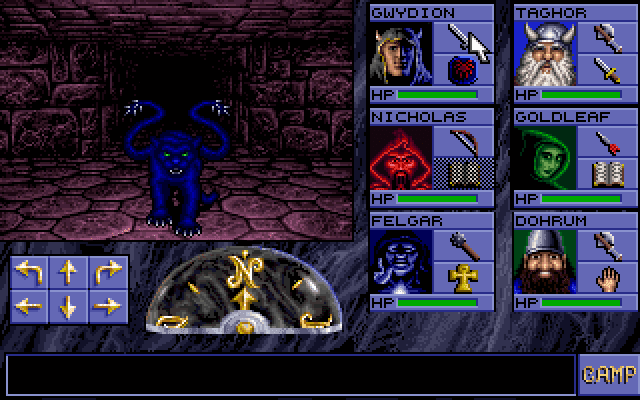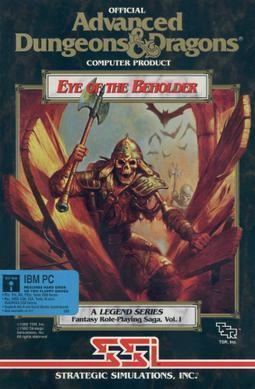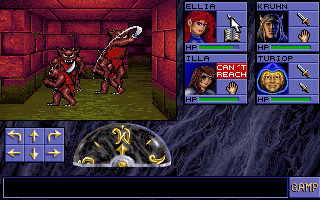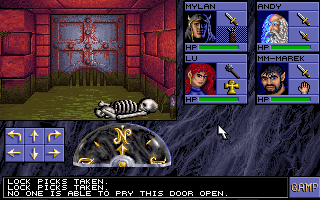8.4 /10 1 Votes8.4
4.5/5 My Abandonware Genre Role-playing video game Mode Single-player video game | 3.9/5 Abandonware DOS Initial release date 16 April 1990 Developer Westwood Studios | |||||||||||||||||||||||||||||||||
Composer(s) PC-98Yuzo KoshiroSega CDYuzo KoshiroMotohiro KawashimaAmigaPaul S. MudraSNESTatsuya Nishimura Platforms Super Nintendo Entertainment System, DOS, Game Boy Advance, Sega Genesis, AmigaOS, PC-9800 series Similar Strategic Simulations games, Role-playing video games | ||||||||||||||||||||||||||||||||||
Eye of the Beholder is a role-playing video game for computers and video game consoles developed by Westwood Associates. It was published by Strategic Simulations, Inc. in January 1991 for the DOS operating system and later ported to the Amiga, the Sega CD, Game Boy Advance and the SNES. The Sega CD version features an exclusive soundtrack composed by Yuzo Koshiro. A port to the Atari Lynx handheld was developed by NuFX in 1993, but never officially released.
Contents
- Plot
- Gameplay
- Eye of the Beholder II The Legend of Darkmoon
- Eye of the Beholder III Assault on Myth Drannor
- Collections
- Game Boy Advance version
- Related games
- Reception
- References

The game had two sequels, Eye of the Beholder II: The Legend of Darkmoon, released in 1991, and Eye of the Beholder III: Assault on Myth Drannor, released in 1993. The third game, however, was not written by Westwood, who had been acquired by Virgin Interactive in 1992 and created the Lands of Lore series instead.

Plot

The lords of the city of Waterdeep hire a team of adventurers to investigate an evil coming from beneath the city. The adventurers enter the city's sewer, but the entrance gets blocked by a collapse caused by Xanathar, the eponymous beholder. The team descends further beneath the city, going through Dwarf and Drow clans, to Xanathar's lair, where the final confrontation takes place.

Once the eponymous beholder is killed, the player would be treated to a small blue window describing that the beholder was killed and that the adventurers returned to the surface where they were treated as heroes. Nothing else was mentioned in the ending and there were no accompanying graphics. This was changed in the later released Amiga version, which featured an animated ending.
Gameplay

Eye of the Beholder featured a first-person perspective in a three-dimensional dungeon, similar to Dungeon Master. The player controls four characters, initially, using a point-and-click interface to fight monsters. This can be increased to a maximum of six characters, by resurrecting one or more skeletons from dead non-player characters (NPC), or finding NPCs that are found throughout the dungeons.
The possibility to increase the size of the player's party through the recruiting of NPCs was a tradition in all of the Eye of the Beholder series. It was also possible to import a party from Eye of the Beholder into The Legend of Darkmoon or from The Legend of Darkmoon into Assault on Myth Drannor; thus, a player could play through all three games with the same party.
Eye of the Beholder II: The Legend of Darkmoon
Eye of the Beholder II: The Legend of Darkmoon used a modified version of the first game's engine, added outdoor areas and greatly increased the amount of interaction the player had with their environment, along with substantially more 'roleplaying' aspects to the game.
Eye of the Beholder III: Assault on Myth Drannor
Eye of the Beholder III: Assault on Myth Drannor was not developed by Westwood, the developer of Eye of the Beholder and The Legend of Darkmoon, but rather in-house by the publisher SSI.
Collections
Eye of the Beholder Trilogy (1995, SSI) was a rerelease of all the three games for DOS on CD-ROM. They also (as did a number of other AD&D DOS Games) appeared later in Gamefest: Forgotten Realms Classics (2001, Interplay).
Game Boy Advance version
A game titled Dungeons & Dragons: Eye of the Beholder was released for the Game Boy Advance that uses a "stripped down version of the 3rd edition D&D rules" with "only four basic character classes". It is not a port of the original game, though it possesses roughly the same plot. It bears stronger resemblance to the original Gold Box games, such as Pool of Radiance.
According to GameSpy, this game "only managed to be a curiosity for older gamers and an annoying Western-style RPG for a new generation of Nintendo fans who had no idea what a Gold Box game was".
Related games
Several modules for Neverwinter Nights (2002) have been created by fans as remakes of the original Eye of the Beholder game.
Reception
Eye of the Beholder was reviewed in 1991 in Dragon #171 by Hartley, Patricia, and Kirk Lesser in "The Role of Computers" column. The reviewers gave the game 5 out of 5 stars. Dennis Owens of Computer Gaming World called it "a stunning, brilliantly graphic and agonizingly tricky" 3-D CRPG. The magazine stated that the game's VGA graphics and sound card audio finally gave IBM PC owners a Dungeon Master-like game. Scorpia, another reviewer for the magazine, was less positive. Although also praising the graphics and audio, stating that they "really give you the feeling of being in an actual dungeon", she criticized the awkward spell user interface and the "outrageous" abrupt ending. Other areas that needed work included the combat, plot, and NPC interaction; nonetheless, she was hopeful that with such improvements "the Legend series will become one of the leaders in the CRPG field". In 1993 Scorpia called the game "an impressive first effort that bodes well for the future".
According to GameSpy in 2004, despite the issues in the first Eye of the Beholder, "most players found the game well worth the effort". CRPG Addict in 2015 gave it a 41 out of 100 score, six points lower than the score for Dungeon Master. He criticized the combat system and lack of in-game economy, but approved of the graphics, sound, user interface, and gameplay, concluding with "I enjoyed it ... It just wasn't as good as it could have been".
Hailing the game as "a dream come true" for Dungeons & Dragons fans, Electronic Gaming Monthly gave the Super NES version a 6.2 out of 10, praising its 3-D graphics and variety of characters. They gave the Sega CD version a 7.2 out of 10, this time praising the ability to create custom characters but criticizing the audio. They also remarked that the game has a difficult learning curve.
Ian Williams of Paste rated the game #8 on his list of "The 10 Greatest Dungeons and Dragons Videogames" in 2015.
